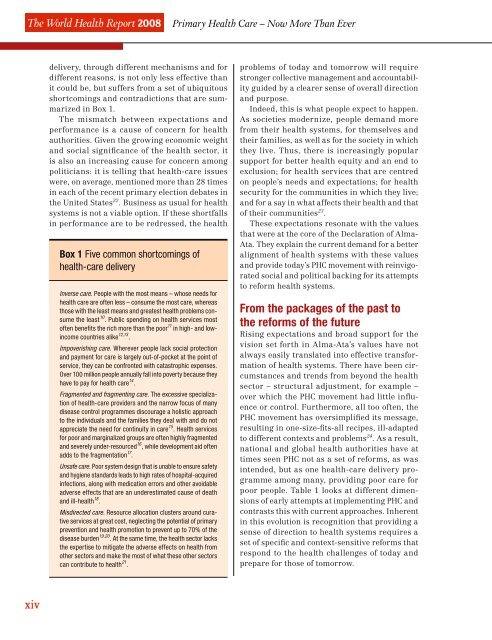Primary health care: now more than ever - World Health Organization
Primary health care: now more than ever - World Health Organization
Primary health care: now more than ever - World Health Organization
Create successful ePaper yourself
Turn your PDF publications into a flip-book with our unique Google optimized e-Paper software.
The <strong>World</strong> <strong>Health</strong> Report 2008<strong>Primary</strong> <strong>Health</strong> Care – Now More Than Everdelivery, through different mechanisms and fordifferent reasons, is not only less effective <strong>than</strong>it could be, but suffers from a set of ubiquitousshortcomings and contradictions that are summarizedin Box 1.The mismatch between expectations andperformance is a cause of concern for <strong>health</strong>authorities. Given the growing economic weightand social significance of the <strong>health</strong> sector, itis also an increasing cause for concern amongpoliticians: it is telling that <strong>health</strong>-<strong>care</strong> issueswere, on average, mentioned <strong>more</strong> <strong>than</strong> 28 timesin each of the recent primary election debates inthe United States 22 . Business as usual for <strong>health</strong>systems is not a viable option. If these shortfallsin performance are to be redressed, the <strong>health</strong>Box 1 Five common shortcomings of<strong>health</strong>-<strong>care</strong> deliveryInverse <strong>care</strong>. People with the most means – whose needs for<strong>health</strong> <strong>care</strong> are often less – consume the most <strong>care</strong>, whereasthose with the least means and greatest <strong>health</strong> problems consumethe least 10 . Public spending on <strong>health</strong> services mostoften benefi ts the rich <strong>more</strong> <strong>than</strong> the poor 11 in high- and lowincomecountries alike 12,13 .Impoverishing <strong>care</strong>. Wher<strong>ever</strong> people lack social protectionand payment for <strong>care</strong> is largely out-of-pocket at the point ofservice, they can be confronted with catastrophic expenses.Over 100 million people annually fall into poverty because theyhave to pay for <strong>health</strong> <strong>care</strong> 14 .Fragmented and fragmenting <strong>care</strong>. The excessive specializationof <strong>health</strong>-<strong>care</strong> providers and the narrow focus of manydisease control programmes discourage a holistic approachto the individuals and the families they deal with and do notappreciate the need for continuity in <strong>care</strong> 15 . <strong>Health</strong> servicesfor poor and marginalized groups are often highly fragmentedand s<strong>ever</strong>ely under-resourced 16 , while development aid oftenadds to the fragmentation 17 .Unsafe <strong>care</strong>. Poor system design that is unable to ensure safetyand hygiene standards leads to high rates of hospital-acquiredinfections, along with medication errors and other avoidableadverse effects that are an underestimated cause of dea<strong>than</strong>d ill-<strong>health</strong> 18 .Misdirected <strong>care</strong>. Resource allocation clusters around curativeservices at great cost, neglecting the potential of primaryprevention and <strong>health</strong> promotion to prevent up to 70% of thedisease burden 19,20 . At the same time, the <strong>health</strong> sector lacksthe expertise to mitigate the adverse effects on <strong>health</strong> fromother sectors and make the most of what these other sectorscan contribute to <strong>health</strong> 21 .problems of today and tomorrow will requirestronger collective management and accountabilityguided by a clearer sense of overall directionand purpose.Indeed, this is what people expect to happen.As societies modernize, people demand <strong>more</strong>from their <strong>health</strong> systems, for themselves andtheir families, as well as for the society in whichthey live. Thus, there is increasingly popularsupport for better <strong>health</strong> equity and an end toexclusion; for <strong>health</strong> services that are centredon people’s needs and expectations; for <strong>health</strong>security for the communities in which they live;and for a say in what affects their <strong>health</strong> and thatof their communities 23 .These expectations resonate with the valuesthat were at the core of the Declaration of Alma-Ata. They explain the current demand for a betteralignment of <strong>health</strong> systems with these valuesand provide today’s PHC movement with reinvigoratedsocial and political backing for its attemptsto reform <strong>health</strong> systems.From the packages of the past tothe reforms of the futureRising expectations and broad support for thevision set forth in Alma-Ata’s values have notalways easily translated into effective transformationof <strong>health</strong> systems. There have been circumstancesand trends from beyond the <strong>health</strong>sector – structural adjustment, for example –over which the PHC movement had little influenceor control. Further<strong>more</strong>, all too often, thePHC movement has oversimplified its message,resulting in one-size-fits-all recipes, ill-adaptedto different contexts and problems 24 . As a result,national and global <strong>health</strong> authorities have attimes seen PHC not as a set of reforms, as wasintended, but as one <strong>health</strong>-<strong>care</strong> delivery programmeamong many, providing poor <strong>care</strong> forpoor people. Table 1 looks at different dimensionsof early attempts at implementing PHC andcontrasts this with current approaches. Inherentin this evolution is recognition that providing asense of direction to <strong>health</strong> systems requires aset of specific and context-sensitive reforms thatrespond to the <strong>health</strong> challenges of today andprepare for those of tomorrow.xiv

















